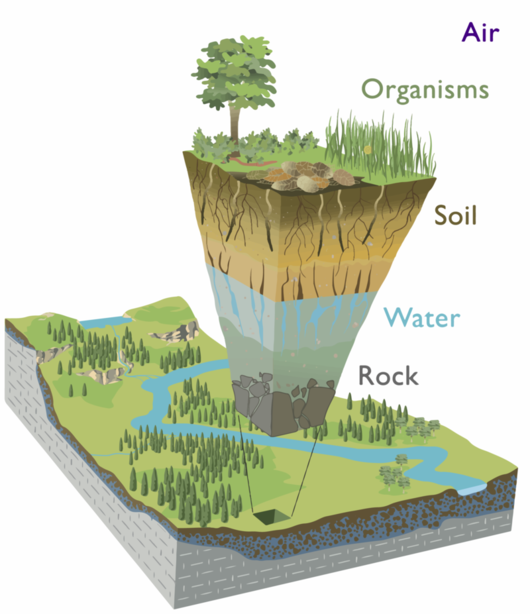Critical zone: Difference between revisions
Jump to navigation
Jump to search
No edit summary |
No edit summary |
||
| Line 1: | Line 1: | ||
[[File:CriticalZone.png|thumb|upright=1.75|Depiction of the Critical Zone.]] | [[File:CriticalZone.png|thumb|upright=1.75|Depiction of the Critical Zone.]] | ||
The Critical Zone is a theoretical concept that connects the atmosphere, vegetation, [[soil]], water, and nutrient availability for life systems. The concept was first published by the National Research Council in 2000, and their initial depiction of it describes it as the "heterogeneous, near surface environment in which complex interactions involving rock, soil, water, air, and living [[organisms]] regulate the natural habitat and determine the availability of life-sustaining resources". [1] | The Critical Zone is a theoretical concept that connects the atmosphere, vegetation, [[soil]], water, and nutrient availability for life systems. An overarching idea that. if correct, connects all systems within this zone and regulates all of terrestrial life. The concept was first published by the National Research Council in 2000, and their initial depiction of it describes it as the "heterogeneous, near-surface environment in which complex interactions involving rock, soil, water, air, and living [[organisms]] regulate the natural habitat and determine the availability of life-sustaining resources". [1] | ||
---------------------------------------------------------------------------------------------------------------------------------------------------------------------------------- | ---------------------------------------------------------------------------------------------------------------------------------------------------------------------------------- | ||
Revision as of 11:46, 12 May 2022

The Critical Zone is a theoretical concept that connects the atmosphere, vegetation, soil, water, and nutrient availability for life systems. An overarching idea that. if correct, connects all systems within this zone and regulates all of terrestrial life. The concept was first published by the National Research Council in 2000, and their initial depiction of it describes it as the "heterogeneous, near-surface environment in which complex interactions involving rock, soil, water, air, and living organisms regulate the natural habitat and determine the availability of life-sustaining resources". [1]
References
[1] Council, National Research. Basic Research Opportunities in Earth Science. 2000. nap.nationalacademies.org, https://doi.org/10.17226/9981.